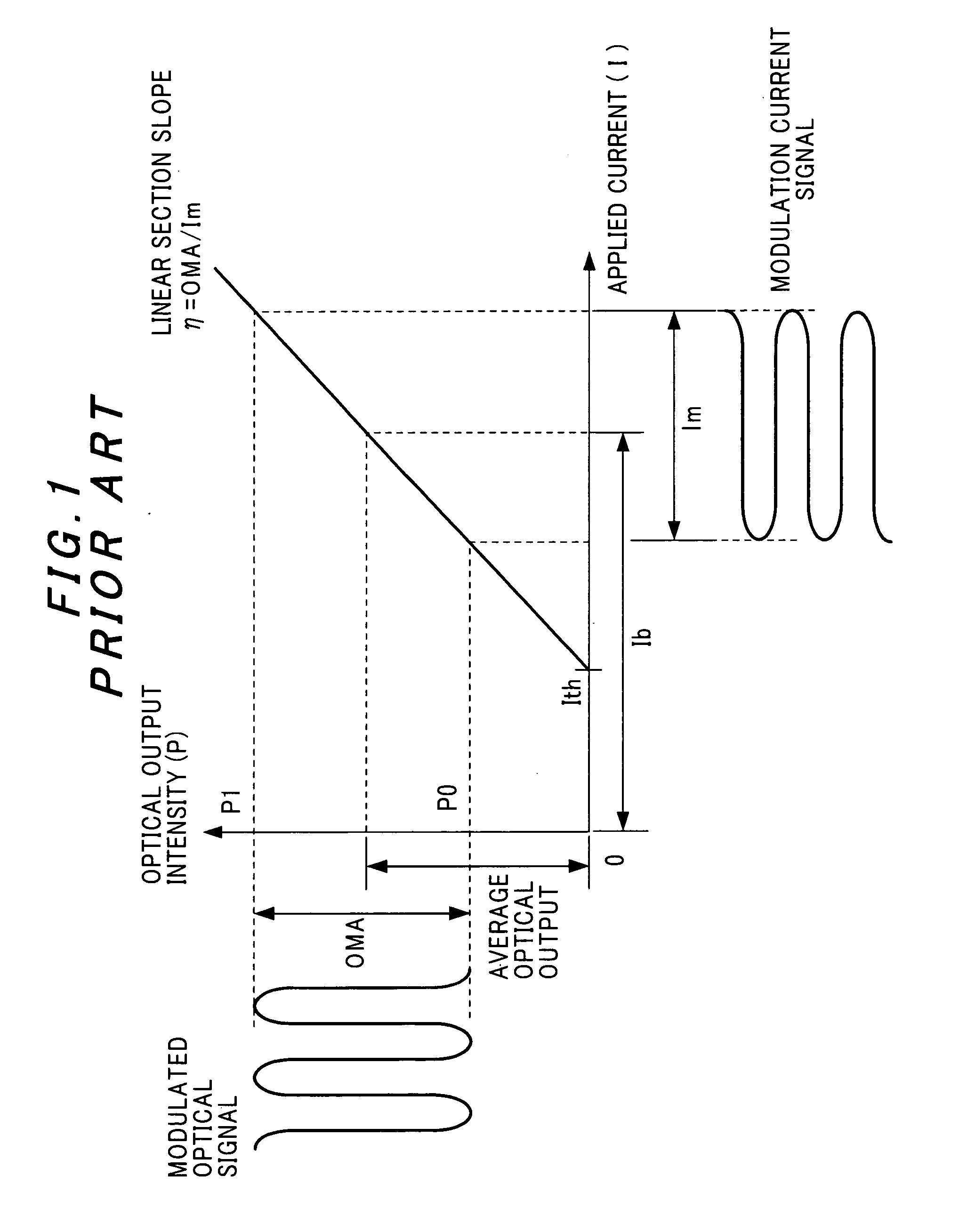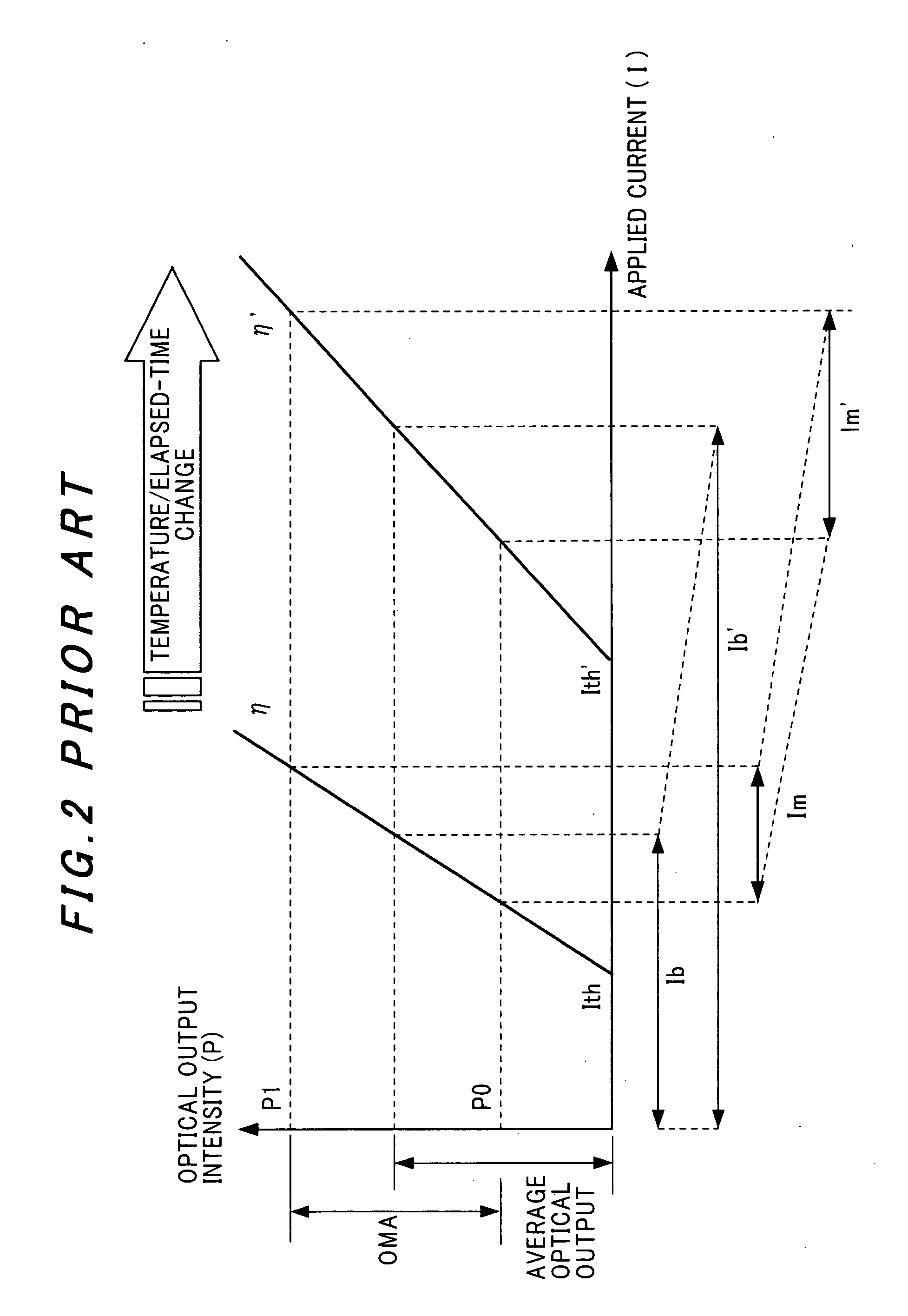Control method and control circuit for laser diode, and optical transmitter using the same
a control method and control circuit technology, applied in the direction of laser details, semiconductor lasers, electrical devices, etc., can solve the problems of deterioration in waveform, increase in jitter of optical transmission signals, so as to prevent deterioration of optical signal characteristics, easy adjustment, and high-density packaging
- Summary
- Abstract
- Description
- Claims
- Application Information
AI Technical Summary
Benefits of technology
Problems solved by technology
Method used
Image
Examples
first embodiment
(Composition of Optical Transmitter)
[0049]FIG. 3 is a circuit diagram showing an optical transmitter in the first preferred embodiment of the invention.
[0050] The optical transmitter 100 is composed of: LD (laser diode) 1 that emits to an optical waveguide etc. laser light with intensity according to a bias current and a modulation current; a modulation circuit 2 that generates a modulation current to be applied to the LD 1; a current source 3 that applies current to the modulation circuit 2; a current source 4 that applies bias current to the LD 1; a photodiode (PD) 5, light receiving element that is optically coupled to the backward output of LD 1 to monitor the optical output of LD 1; an optical output measurement circuit 6; a temperature measurement circuit 7 that measures a surrounding temperature; a microprocessor 8 as a controller with a program installed therein; a nonvolatile memory 9 that is connected to the microprocessor 8 and stores target values of optical output an...
second embodiment
[0058]FIG. 4 is a flowchart showing a control method for laser diode in the second preferred embodiment of the invention as well as showing the operation of the optical transmitter in the first embodiment. The method or operation is conducted by the microprocessor 8. In FIG. 4, S means a step.
[0059]FIG. 5 is a characteristic diagram showing the relationship between a variation in optical output and bias current and a variation in slope efficiency.
[0060] Referring to FIG. 3 to 5, the control method for laser diode and the operation of microprocessor will be explained below.
[0061] In the second embodiment, the optical output and OMA (optical modulation amplitude) are automatically controlled according to the temperature change and elapsed-time change of oscillation threshold Ith and slope efficiency η.
[0062] First, the microprocessor 8 outputs the initial values of bias current Ib and modulation current Im to control the current sources 3 and 4 (S201). These initial values are mad...
third embodiment
(Method of Controlling the Laser Diode)
[0071]FIG. 6 shows a control method for laser diode in the third preferred embodiment of the invention. In FIG. 6, S means step.
[0072] The third embodiment is different from the second embodiment in the procedures of S201 and S202 as described in the second embodiment. The processing shown in FIG. 6 is also conducted by the microprocessor 8 based on the program stored in the nonvolatile memory 9.
[0073] The microprocessor 8 conducts the procedures in S201, and then it measures a variation of bias current ΔIb, as a corresponding value of η, varied with the change of optical output (S202). Then, it is judged whether or not ΔP (variation of optical output)=ΔPs (preset value) (S301). If the ΔP measured by the optical output measurement circuit 6 coincides with the predetermined ΔPs, the processing of microprocessor 8 is shifted to S204. In S204, a modulation current Im is outputted in proportional to the measured ΔIb. After that, until the optic...
PUM
 Login to View More
Login to View More Abstract
Description
Claims
Application Information
 Login to View More
Login to View More - R&D
- Intellectual Property
- Life Sciences
- Materials
- Tech Scout
- Unparalleled Data Quality
- Higher Quality Content
- 60% Fewer Hallucinations
Browse by: Latest US Patents, China's latest patents, Technical Efficacy Thesaurus, Application Domain, Technology Topic, Popular Technical Reports.
© 2025 PatSnap. All rights reserved.Legal|Privacy policy|Modern Slavery Act Transparency Statement|Sitemap|About US| Contact US: help@patsnap.com



